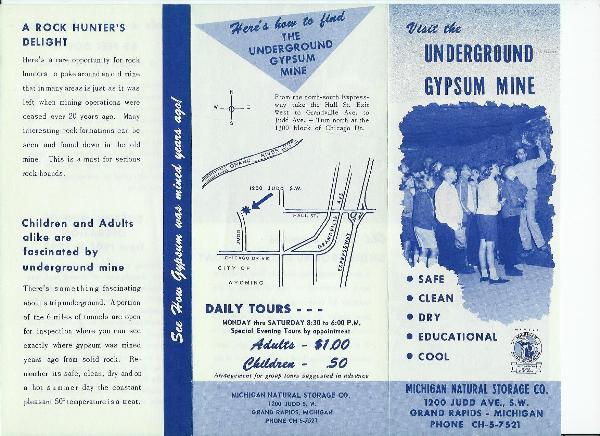
Photo courtesy of the Wyoming Historical Commission
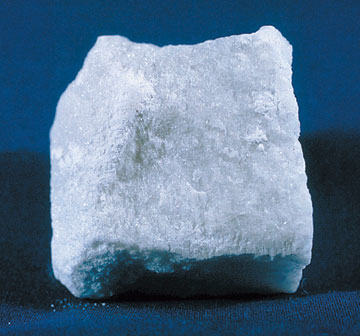
Gypsum Rock
Gypsum was first discovered in West Michigan in 1827 near the
mouth of what we know as Plaster Creek. That put Michigan on the
map for mining the mineral gypsum. The gypsum deposit in West
Michigan is estimated to be a 40 to 50 miles wide. The tunnels here
crisscross from Wyoming to Walker, Grand Rapids to Grandville.
There is about 6 miles of tunnels for this local mine in West
Michigan. Many years ago, when the mine was operating, gypsum was
mined using dynamite. Then it was hauled to the surface using one
of the two mine shafts. The tunnels here are 50° Fahrenheit year
round.
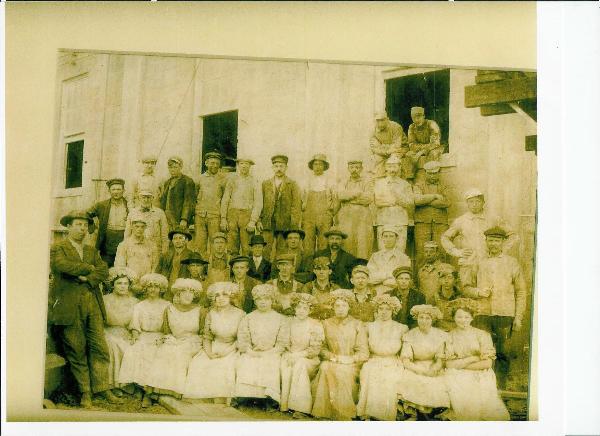
Photo courtesy of the Wyoming Historical Commission
Gypsum is CaSO4 2H2O, Hydrated Calcium Sulfate. Gypsum is a
mineral found in sedimentary environments throughout the world. It
is commonly found in large deposits resulting from precipitation
from saline waters. Its formation it may have other mineral
deposits including air bubbles created during its formation.
Common names of gypsum include Selenite, Satin spar, and
Alabaster. Selenite is a colorless and transparent variety that can
show pearl-like luster, and may have a banded appearance. Satin
spar gypsum has a fibrous appearance, and is often times a milky
white or pink color. Alabaster is a fine grained massive material
that is carved into ornaments. Gypsum’s color may range from white,
gray, and shades of red, brown, or yellow.
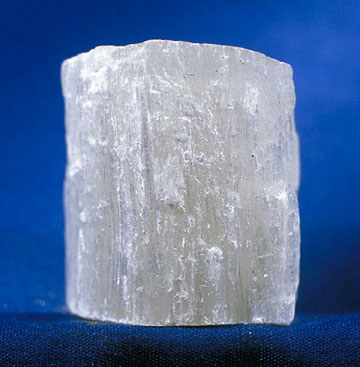
Satin Spar Gypsum
Gypsum is commonly used for wall board or sheet rock as it may
be also known as. Gypsum inclusion in wall boards adds a little
added value of fire protection. Some estimates say that the average
American home contains 7 metric tons of gypsum. It is also added to
concrete as a strengthener for roads, bridges, and sidewalks.
Gypsum has also been used as a fertilizer. Gypsum adds calcium
and sulfur to the soil if the soil lacks sufficient quantities of
those minerals. The end result increases crop productivity for
farmers. I can remember in my earlier days growing up on a farm my
dad ordering product and having it delivered and then spread on the
land we would grow crops on.
Historically, gypsum has been used for sculptures because of the
softness of the mineral. The Egyptians discovered over 5000 years
ago that if they would grind up the gypsum to a power form and then
add water (what we call Plaster of Paris) – they could use it for
their living quarters. They would use it for their walls much like
we do today in the form of sheet rock wall boards.
Selenite, the transparent form of gypsum, was used for windows
before the common use of glass.
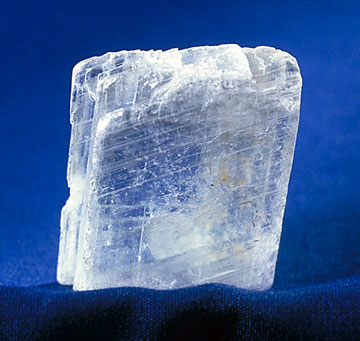
Selenite Gypsum
Locally, in November of 2005, a resident of the City of Wyoming,
had their garage and its contents (including a car) to be swallowed
up by is thought to be an underground gypsum mine. However, due to
the lost and the lack of maps it cannot be confirmed that it was
actually a mine tunnel or a sink hole. Many homes and property in
the surrounding area Grand Rapids, Wyoming, Grandville, Walker, and
even Kentwood, are above old mine tunnels which are anywhere from
65 to 85 feet below them without even realizing that.
As a result of mining of the mineral gypsum in years past, a
portion of us 131 was found to be sinking. Mining had left voids in
sub-terrain surfaces. The stability of Grand Rapids most
recognizable curve, the “S curve” was being affected. M-DOT said
the “S curve” needed to be replaced. In January 2000, the entire 1
mile segment was shut down for total reconstruction for almost a
total of 300 days to the delight of area commuters!
This Earth cache will take you to the former site of the
Alabastine Mining Company. The Alabastine Mining Company began
operations here in the 1890’s and continued it’s operations until
1943 when the company went bankrupt. In 1946, Bert Kragt and his
son Paul, purchased the site with the intent to produce furniture
here in Furniture City. However, that endeavor did not work out
very well. Kragt then realized that he could utilize the old
abandoned mine tunnels for storage in a humidity and temperature
controlled environment. Bert along with his son began to pour
concrete through the tunnels to create an “underground warehouse”
for the perfect and secure location to store goods. Today, Michigan
Natural Storage sits at this site. On a normal day over 40 – 50
semis either drop off or pickup goods from the mine tunnels.
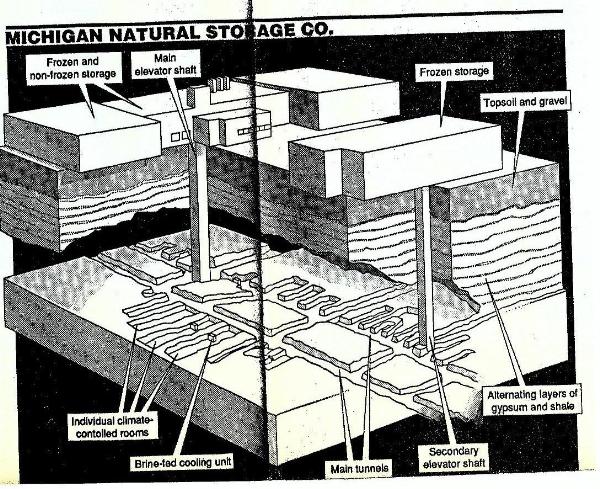
Photo courtesy of the Wyoming Historical Commission

Photo courtesy of the Wyoming Historical Commission
This Earth cache has been placed with the permission of the
Michigan Natural Storage. They are aware of it and actually gave me
the location of a great spot to have your photo taken.
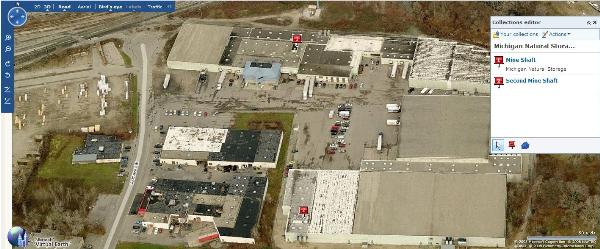
To receive credit for this cache:
1) Visit the location and have your photo taken with the Michigan
Natural Storage sign in the background. Post the photo with your
log.
2) How was the gypsum transported away from the mines? When you are
at the mine site - look around you - and you will see the answer.
Email me using the link above and please do not post the answers
with your log.
Each Cacher that logs a find is required to submit answers to
the questions above (failure to comply will result in a deletion of
your log). The only exception to this are young kids that are
caching with their parents (who have their own account, but not
computer privileges). Per Earthcache guidelines, each cacher is to
learn from their visit/experience. That means each cacher must
perform the necessary task(s) or requirements to log the cache and
earn your smiley.
Any logs that do not meet the above posted requirements will be
deleted at the discretion of the cache owner. All logging
requirements must be completed within 48 hours of logging the cache
online or your log will be deleted unless you have prior permission
from the cache owner.
Information compiled from this cache was used from:
Wood TV8
The Mineral Gypsum by Jacob Bray – Emporia State University